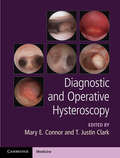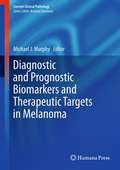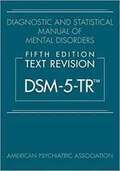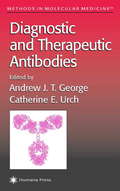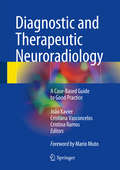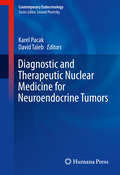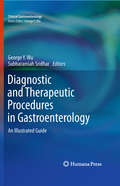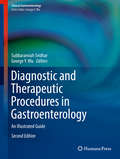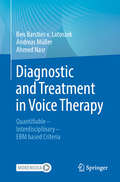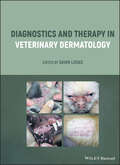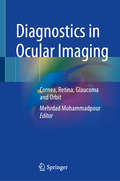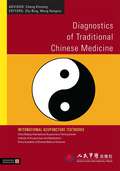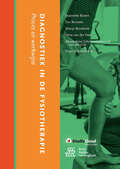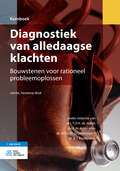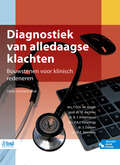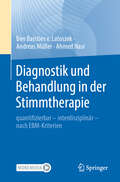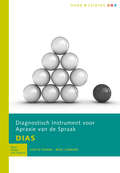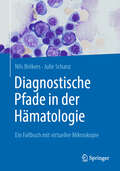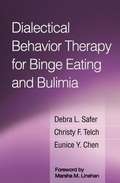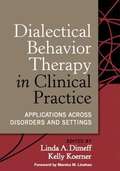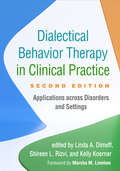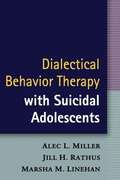- Table View
- List View
Diagnostic and Operative Hysteroscopy
by T. Justin Clark Mary E. ConnorThis expert guide will help readers learn about the role of hysteroscopy in the management of a range of common and less common gynaecological problems. In particular, the book covers the diagnosis and treatment of endometrial and uterine anatomical abnormalities that are associated with abnormal uterine bleeding and impairment of reproduction. Contemporary hysteroscopic techniques are described allowing the reader to understand how to perform both inpatient and outpatient procedures. Based on the annual RCOG/BSGE Diagnostic and Operative Hysteroscopy training course, this comprehensive guide covers fundamental topics such as equipment, energy modalities and operative set up. The book also explores innovative ambulatory surgery and hysteroscopic interventions in an operating theatre environment. Written by international experts in hysteroscopy and including sections on training in, and monitoring of clinical practice, this guide proves an ideal companion for health care professionals looking to provide best clinical practice and optimal patient experience.
Diagnostic and Prognostic Biomarkers and Therapeutic Targets in Melanoma
by Michael J. MurphyThis book describes both the technologies used in the discovery of melanoma biomarkers and the clinical application of these biomarkers for diagnosis and staging of disease, determination of prognosis, treatment planning, monitoring of response to therapy, identification of novel therapeutic targets and drug development. A broad range of biomarkers (DNA/chromosomal, mRNA, microRNA, mitochondrial DNA, epigenetic and protein) is outlined. As therapies for melanoma become increasingly more target specific, the identification, validation and use of biomarkers will invariably play a greater role in the management of patients with this disease. Diagnostic and Prognostic Biomarkers and Therapeutic Targets in Melanoma is an essential resource for oncologists, dermatologists, dermatopathologists, general pathologists with an interest in melanoma, and melanoma researchers.
Diagnostic and Statistical Manual of Mental Disorders, Text Revision (DSM-5-TR)
by American Psychiatric AssociationThe Diagnostic and Statistical Manual of Mental Disorders, Fifth Edition, Text Revision (DSM-5-TR), is the most comprehensive, current, and critical resource for clinical practice available to today's mental health clinicians and researchers. <p><p>DSM-5-TR includes the fully revised text and references, updated diagnostic criteria and ICD-10-CM codes since DSM-5 was published in 2013. It features a new disorder, Prolonged Grief Disorder, as well as codes for suicidal behavior available to all clinicians of any discipline without the requirement of any other diagnosis. <p><p>With contributions from over 200 subject matter experts, this updated volume boasts the most current text updates based on the scientific literature. Now in four-color and with the ability to authenticate each printed copy, DSM-5-TR provides a cohesive, updated presentation of criteria, diagnostic codes, and text. <p><p>This latest volume offers a common language for clinicians involved in the diagnosis and study of mental disorders and facilitates an objective assessment of symptom presentations across a variety of clinical settings—inpatient, outpatient, partial hospital, consultation-liaison, clinical, private practice, and primary care. <p><p>Stay current with these important updates in DSM-5-TR: • Fully revised text for each disorder with updated sections on associated features, prevalence, development and course, risk and prognostic factors, culture, diagnostic markers, suicide, differential diagnosis, and more.• Addition of Prolonged Grief Disorder (PGD) to Section II—a new disorder for diagnosis• Over 70 modified criteria sets with helpful clarifications since publication of DSM-5• Fully updated Introduction and Use of the Manual to guide usage and provide context for important terminology• Considerations of the impact of racism and discrimination on mental disorders integrated into the text• New codes to flag and monitor suicidal behavior, available to all clinicians of any discipline and without the requirement of any other diagnosis• Fully updated ICD-10-CM codes implemented since 2013, including over 50 coding updates new to DSM-5-TR for substance intoxication and withdrawal and other disorders• Updated and redesigned Diagnostic Classification <p><p>This manual is a valuable resource for other physicians and health professionals, including psychologists, counselors, nurses, and occupational and rehabilitation therapists, as well as social workers and forensic and legal specialists. The new DSM-5-TR is the most definitive resource for the diagnosis and classification of mental disorders.
Diagnostic and Therapeutic Antibodies (Methods in Molecular Medicine #40)
by Andrew J.T. George Catherine E. UrchA team of experts comprehensively review the theoretical and practical aspects of applying antibodies in both the laboratory and clinic. For general understanding, the book thoroughly introduces the basic science of the antibody molecule, including recombinant engineering. Several novel in vivo applications of therapeutic antibodies are then presented to illustrate their special value in varied clinical settings. For those new to the field, there are readily reproducible methods for generating and purifying antibodies and for modifying them for clinical application. Timely and comprehensive, Diagnostic and Therapeutic Antibodies offers today's researchers a concise introduction to the field, as well as a highly useful compendium of practical protocols that will greatly facilitate the application of these powerful new diagnostic and therapeutic agents.
Diagnostic and Therapeutic Neuroradiology
by João Xavier Cristiana Vasconcelos Cristina RamosThis book presents a wide-ranging series of illustrative clinical cases that cover the main pathologies and areas of interest in diagnostic and therapeutic neuroradiology. The aim is to enable the reader to learn important lessons from real cases that exemplify the caseload and capabilities of a large, modern neuroradiology department. The cases are presented in a quiz format. For each one, the first page documents clinical and imaging findings, followed by questions concerning these findings, differential diagnosis, and other aspects. On the second page, the answers are provided, with concise explanation and discussion. Attention is also drawn to the relevant available literature. Most of the cases derive from the Department of Neuroradiology at the University Hospital Center of Porto (Portugal), which is staffed by a large multidisciplinary team providing cutting-edge services. In addition, some cases from other centers have been included to ensure wider representation of experience. The book will be of particular value for residents and fellows in neuroradiology, radiology, neurology, and neurosurgery.
Diagnostic and Therapeutic Nuclear Medicine for Neuroendocrine Tumors
by Karel Pacak David TaïebBased on the most novel approaches and cutting-edge clinical and scientific information regarding radionuclide imaging and therapies for neuroendocrine tumors, this clinical guidebook represents a unique collaborative effort between endocrinologists, nuclear physicians, oncologists, surgeons, physicists, radio-pharmacists and geneticists. It begins with the embryology, classification and molecular genetics of gastroenteropancreatic neuroendocrine tumors and carcinoids, chromaffin cell tumors, and MEN1- and MEN2-related tumors. Following a chapter on radiopharmaceuticals in neuroendocrine imaging, it turns to the physics and technology of current and cutting-edge radiology, including SPECT/CT and PET/CT and PET/MR. Discussing of radionuclide imaging covers the tumors mentioned above, as well as pulmonary and thymic neuroendocrine tumors and medullary thyroid carcinoma. A presentation of radionuclide therapies follows, including 131I-MIBG therapy, somatostatin receptor-based therapy, and alpha radionuclide therapy, as well as the role of nanoparticles. Comprehensive and up-to-date, Diagnostic and Therapeutic Nuclear Medicine for Neuroendocrine Tumors will assist and guide physicians who encounter patients with these conditions, either from a diagnostic or therapeutic standpoint, and particularly emphasizes the current and emerging medical devices and imaging and therapeutic options.
Diagnostic and Therapeutic Procedures in Gastroenterology
by George Y. Wu Subbaramiah SridharDiagnostic and Therapeutic Procedures in Gastroenterology: An Illustrated Guide is a comprehensive volume describing procedures for the gastrointestinal tract in a simple way. Artistic illustrations are provided to educate the physician about procedures, and to provide not only clear descriptions of the changes in the anatomy and physiology, but also to provide advice on medical management of the post-procedure patient. Clear, detailed, artist-rendered illustrations of the anatomy are included as well as appropriate, radiological images. Chapters describe in detail the indications, contraindications, anatomical alterations, and physiological alterations that result from various operations and procedures. Comparisons between alternative operations, complications, medical management issues, and costs are also discussed. Diagnostic and Therapeutic Procedures in Gastroenterology: An Illustrated Guide is a unique volume, written primarily for primary care physicians and general internists. It is also suitable for medical students, residents, nurses and nurse practitioners, nutritionists, dietitians and various subspecialists, who take care of patients with gastrointestinal disorders.
Diagnostic and Therapeutic Procedures in Gastroenterology
by George Y. Wu Subbaramiah SridharDiagnostic and Therapeutic Procedures in Gastroenterology: An Illustrated Guide is a comprehensive volume describing procedures for the gastrointestinal tract in a simple way. Artistic illustrations are provided to educate the physician about procedures, and to provide not only clear descriptions of the changes in the anatomy and physiology, but also to provide advice on medical management of the post-procedure patient. Clear, detailed, artist-rendered illustrations of the anatomy are included as well as appropriate, radiological images. Chapters describe in detail the indications, contraindications, anatomical alterations, and physiological alterations that result from various operations and procedures. Comparisons between alternative operations, complications, medical management issues, and costs are also discussed. Diagnostic and Therapeutic Procedures in Gastroenterology: An Illustrated Guide is a unique volume, written primarily for primary care physicians and general internists. It is also suitable for medical students, residents, nurses and nurse practitioners, nutritionists, dietitians and various subspecialists, who take care of patients with gastrointestinal disorders.
Diagnostic and Treatment in Voice Therapy: Quantifiable - Interdisciplinary - EBM based Criteria
by Andreas Müller Ben Barsties v. Latoszek Ahmed NasrThis book describes modern multidimensional-quantitative methods in voice diagnosis based on EBM evidence and proposes an evidence-based minimal standard in voice diagnosis. It provides the necessary scientific background combined with practical implementation. Current scientific findings from recent years provide speech-language pathologists, voice and speech therapists, as well as physicians in otolaryngology with new opportunities for the medical and therapeutic care of voice patients. Voice diagnostics and various voice treatments for heterogeneous voice disorders can thus be better integrated to apply structured clinical reasoning for voice treatment. Plus: Numerous videos, audios, and downloadable work materials facilitate implementation in practice.
Diagnostic, Prognostic and Therapeutic Value of Gene Signatures
by Antonio Russo Stefano Iacobelli Juan IovannaGene expression studies have revealed diagnostic profiles and upregulation of specific pathways in many solid tumors. The explosion of new information in gene expression profiling could potentially lead to the development of tailored treatments in many solid tumors. In addition many studies are ongoing to validate these signatures also in predicting response to hormonal, chemotherapeutic and targeted agents in breast cancer as well as in other tumors. Diagnostic, Prognostic and Therapeutic Value of Gene Signatures provides readers a useful and comprehensive resource about the range of applications of microarray technology in oncological diseases. Topics covered include gene signatures and soft tissue sarcomas, prognostic relevance of breast cancer signatures, gene expression profiling of colorectal cancer and liver metastasis, gene signatures in GISTs, CNVs and gene expression profiles in pancreatic cancer, and gene signatures in head/neck, lung and gastric tumors. Diagnostic, Prognostic and Therapeutic Value of Gene Signatures will be of great value to residents and fellows, physicians, pathologists and medical oncologists.
Diagnostics and Therapy in Veterinary Dermatology
by Dawn LogasDiagnostics and Therapy in Veterinary Dermatology presents thorough coverage of the latest discoveries, drugs, and treatments for dermatologic conditions in animals. Chapters written by experts in each respective area of veterinary dermatology contain up-to-date information on new diagnostic tools and tests, autoimmune diseases, parasitic and fungal infections, medical management of acute and chronic conditions, alternative dermatologic therapies, and more. Offering practical solutions for both specialist and general practice veterinarians dealing with dermatology cases, this wide-ranging resource also addresses antibiotic resistance and misuse, the availability of foods for elimination diet trials, problems with generic drugs, emerging infectious diseases, and other important problems currently facing the profession. Throughout the text, veterinary practitioners are provided with real-world guidance on improving how they work up their dermatology cases and strengthening communication between the primary care veterinarian and the dermatologist. Edited by a leading board-certified dermatologist, this volume: Focuses on cats and dogs Includes numerous high-quality clinical photographs illustrating all key concepts Covers topics such as how to use your nursing staff to the fullest, the One Health movement, and how changing climate is increasing the spread of certain dermatologic diseases Discusses approaches for building a better working relationship between clients, primary care veterinarians and dermatologists Provides insights on the future of technology in the diagnosis and treatment of dermatologic diseases Covering the very latest developments in the field, Diagnostics and Therapy in Veterinary Dermatology is essential reading for veterinary dermatologists, veterinary students, and any veterinary general practitioner with a dermatology caseload.
Diagnostics in Ocular Imaging: Cornea, Retina, Glaucoma and Orbit
by Mehrdad MohammadpourThis book presents a new avenue in the field of ophthalmology and sheds light on the field of eye imaging. With the increasing availability of electronic devices and their important role in both personal and professional aspects of human life, there is a growing need for perfect vision. Ophthalmic imaging is a major tool for screening and documenting eye diseases in both medical and surgical fields of ophthalmology and is also of use for ophthalmologists around the globe. The number of eye-imaging devices has increased dramatically, however undiagnosed or poorly managed eye diseases remain a significant cause of ocular and visual problems worldwide. This essential guide addresses the need for a book that is dedicated to ophthalmic imaging, covering the cornea, glaucoma, retina and orbital imaging with updates on medical and surgical aspects of the topic.
Diagnostics of Traditional Chinese Medicine
by Hongcai Wang Bing ZhuThe principles and practice of diagnostics are key to administering effective treatment in traditional Chinese medicine. The ability to recognise and diagnose symptoms and complaints correctly is fundamental to deciding on appropriate remedies, and this book provides a comprehensive introduction to all the principles that students and practitioners need to know. The authors outline the key methods used in diagnosis, and describe the eight basic categories of ailment and disease: yin and yang, exterior and interior, cold and heat, and deficiency and excess. They provide detailed instructions on how to identify and rebalance the relative strengths of pathogens and Qi in the body, and how to differentiate between syndromes that might look the same, using traditional Chinese medicine methods. The book concludes with useful forms for completion in taking a diagnosis. Combining practical instruction with detailed theory, this authoritative textbook, compiled by the China Beijing International Acupuncture Training Center (CBIATC), under the editorial direction of leading Chinese clinicians Zhu Bing and Wang Hongcai, is an excellent reference for students and practitioners at all levels.
Diagnostiek in de fysiotherapie: Proces en werkwijze
by J. C. Boiten T. Brouwer M. S. Bunskoek A.E. van der Feen A.S.M. Schimmelpenninck van der Oije F.C. Uilenreef-TobiIn deze uitgave vindt u een overzicht van het totale fysiotherapeutisch handelen. De verschillende fasen van het fysiotherapeutisch proces komen aan bod, waarbij de focus ligt op samenhang tussen kennis, inzicht, attitude en vaardigheden. Het handelen en de werkwijze van de fysiotherapeut staan steeds in relatie tot het proces van probleemoplossing. In elke fase staat methodisch werken centraal. In deze druk van 'Diagnostiek in de fysiotherapie' is er speciale aandacht voor klinisch redeneren en het gebruik van meetinstrumenten. Daarbij stimuleren de auteurs het bewust handelen - eerst denken, dan doen - tijdens alle fasen van het handelen. Ook shared decision making en ondersteuning van zelfmanagement komen aan de orde. Tevens is het KNGF-beroepsprofiel toegevoegd met de competentiegebieden van de fysiotherapeut volgens het CanMEDS-model. Op het gebied van wet- en regelgeving en het systeem van kwaliteitsregistratie is het boek geactualiseerd. 'Diagnostiek in de fysiotherapie' is een onmisbaar boek voor fysiotherapeuten en studenten fysiotherapie. Het biedt een kader om kritisch te reflecteren op de eigen werkwijze als professioneel beroepsbeoefenaar. De nadruk ligt op logisch redeneren en het onderbouwen van keuzes. Daarbij wordt de relatie tussen pati#65533;nt/cli#65533;nt en fysiotherapeut opgevat als een functionele samenwerkingsrelatie. Het volledige boek is ook digitaal beschikbaar met samenvattingen en toetsvragen per hoofdstuk en interessante en verdiepende links.
Diagnostiek van alledaagse klachten: Bouwstenen Voor Rationeel Probleemoplossen (Kernboek Ser.)
by drs. T.O.H. de Jongh dr L. M. H. Grundmeijer dr B. J. Knottnerus Prof. dr. de VriesDiagnostiek is een van de moeilijkste aspecten van de medische praktijk; moeilijk om te doen en nog moeilijker om te leren. De meeste leerboeken gaan immers uit van aandoeningen en ziekten, maar mensen komen met klachten en symptomen naar de arts. De dokter beoordeelt deze vooral op basis van eigen ervaring en die van zijn leermeesters. Diagnostiek van alledaagse klachten wil aan die diagnostiek een logische en wetenschappelijke onderbouwing geven door evidence-based gegevens aan te reiken voor de diagnostiek van 66 veelvoorkomende klachten.Elk hoofdstuk in dit boek behandelt de diagnostiek van een klacht volgens een vaste structuur: de incidentie van de klacht, hoe patiënten deze ervaren, redenen om ermee naar de arts te gaan, de mogelijke oorzaken en de differentiële diagnose. Vervolgens licht het boek de waarde toe van de gegevens uit anamnese, lichamelijk onderzoek en aanvullend onderzoek met betrekking tot de mogelijke diagnosen. De hoofdstukken zijn geschreven door huisartsen en vakspecialisten samen, allen met veel onderwijs- en praktijkervaring.Bij een groot aantal van de behandelde klachten worden instructieve video’s van huisartsconsulten aangeboden op de website bij het boek, kosteloos toegankelijk voor de lezer. Daar is ook de gehele boekinhoud geplaatst, waardoor Diagnostiek van alledaagse klachten snel te doorzoeken en overal online te raadplegen is.Voor deze vierde druk is de inhoud aangevuld en geactualiseerd en het boek is uitgebreid met een nieuw hoofdstuk: vallen bij ouderen.Diagnostiek van alledaagse klachten is bestemd voor studenten in het basiscurriculum, artsen in opleiding en praktiserende artsen. Daarnaast is het ook belangrijk voor docenten, paramedisch beroepsbeoefenaren en alle artsen die de rationaliteit van hun diagnostisch handelen kritisch willen beoordelen.
Diagnostiek van alledaagse klachten: Bouwstenen voor klinisch redeneren
by T.O.H. de Jongh H. De Vries B. J. Knottnerus P.A.J. Keurlings J. Damen M. E. ReindersDiagnostiek is een van de moeilijkste aspecten van de medische praktijk; moeilijk om te doen en nog moeilijker om te leren. De afgelopen decennia is er in het medisch curriculum dan ook in toenemende mate aandacht gekomen voor het onderwijs in klinisch redeneren. Daarbij speelt dit boek Diagnostiek van alledaagse klachten een belangrijke rol.De meeste leerboeken gaan uit van aandoeningen en ziekten, maar mensen komen met klachten en symptomen naar de arts. Daarom geeft dit boek de logische en wetenschappelijke onderbouwing voor de diagnostiek van bijna 70 veelvoorkomende klachten.Elk hoofdstuk in dit boek behandelt de diagnostiek van een klacht volgens een vaste structuur: de incidentie van de klacht, hoe patiënten de klacht ervaren, redenen om ermee naar de arts te gaan, de mogelijke oorzaken en de differentiële diagnose. Vervolgens licht het boek de waarde toe van de gegevens uit anamnese, lichamelijk onderzoek en aanvullend onderzoek met betrekking tot de mogelijke diagnosen. De hoofdstukken zijn geschreven door huisartsen en vakspecialisten samen, allen met veel onderwijs- en praktijkervaring.Bij dit boek hoort een website, die kosteloos toegankelijk is voor de lezer. Daar is de gehele boekinhoud geplaatst, waardoor Diagnostiek van alledaagse klachten snel te doorzoeken en overal online te raadplegen is. Daarnaast staat er van iedere klacht een instructief consultfilmpje of een casus op de website, met bijbehorende verdiepingsvragen.Voor deze vijfde druk is de inhoud aangevuld en geactualiseerd en het boek is uitgebreid met een nieuw klacht: scrotale klachten en enkele algemene hoofdstukken.Diagnostiek van alledaagse klachten is bestemd voor studenten in het basiscurriculum, artsen in opleiding en praktiserende artsen. Daarnaast is het ook belangrijk voor docenten, paramedisch beroepsbeoefenaren en alle artsen die de rationaliteit van hun diagnostisch handelen kritisch willen beoordelen.
Diagnostik und Behandlung in der Stimmtherapie: quantifizierbar - interdisziplinär - nach EBM-Kriterien
by Andreas Müller Ben Barsties v. Latoszek Ahmed NasrDieses Buch beschreibt die modernen multidimensionalen-quantitativen Verfahren in der Stimmdiagnostik, auf der Basis wissenschaftlicher Evidenz und schlägt einen evidenzbasierten Minimalstandard in der Stimmdiagnostik vor. Damit liefert es den notwendigen wissenschaftlichen Hintergrund verbunden mit der praktischen Umsetzung.Aktuelle wissenschaftliche Erkenntnisse der letzten Jahre geben Logopäd*innen, Stimm- und Sprachtherapeut*innen sowie Ärztinnen und Ärzte in der HNO und Phoniatrie neue Möglichkeiten bei der medizinischen und therapeutischen Versorgung von Patienten mit Stimmstörungen. Die Stimmdiagnostik und die unterschiedlichen Stimmbehandlungen von heterogenen Stimmstörungen können somit besser verzahnt werden, um ein Clinical Reasoning für die Stimmbehandlung strukturiert anzuwenden. Plus: Zahlreiche Videos, Audios und Arbeitsmaterialien zum Download erleichtern die Umsetzung in die Praxis.
Diagnostik und chirurgische Therapie kindlicher Hornhauttrübungen: Überblick für Fachärzt*innen der Augenheilkunde und Pädiatrie (essentials)
by Sarah Barbara ZwingelbergDie kindliche Hornhauttrübung gehört weltweit zu den Hauptursachen für Blindheit oder eine schwere Sehbehinderung bei Kindern. Die Ursachen sind hierbei vielfältig und komplex und besitzen ein enges therapeutisches Fenster aufgrund des erhöhten Risikos der Entwicklung einer Amblyopie. Dieses Essential gibt einen komprimierten Überblick zur Diagnostik, Klinik, Genetik und den aktuellen Behandlungsmöglichkeiten von angeborenen Hornhauttrübungen und Dysgenesie des vorderen Augenabschnitts.
Diagnostisch Instrument voor Apraxie van de Spraak (DIAS) handleiding
by Judith Feiken Roel JonkersDoel van de testHet Diagnostisch Instrument voor Apraxie van de Spraak (DIAS) is een instrument waarmee de diagnose ‘spraakapraxie’ gesteld wordt. Daarnaast kan met het DIAS de ernst van de spraakapraxie worden bepaald. Het DIAS is het eerste betrouwbare en gestandaardiseerde instrument voor het specifiek diagnosticeren van spraakapraxie, los van eventueel aanwezige andere stoornissen, zoals afasie en / of dysartrie. Met de test legt men een goede basis voor een passend therapieplan voor de patientgroep met spraakapraxie en het instrument brengt het effect in kaart van specifiek op spraakapraxie gerichte therapie. Het DIAS onderzoekt de aard van de spraakapraxie door na te gaan welke specifieke symptomen van de stoornis aanwezig zijn en in welke mate. Daarnaast bepaalt het instrument het niveau van de doelbewuste articulatie, waarmee de ernst van de spraakapraxie in kaart wordt gebracht. Met het DIAS onderzoekt men patiënten bij wie een vermoeden bestaat dat er sprake is van spraakapraxie of waarbij al is vastgesteld dat er sprake is van spraakapraxie. Het instrument is geschikt om af te nemen aan het eind van de acute fase en bij de aanvang van de revalidatiefase. Om logopedische therapie te kunnen evalueren wordt geadviseerd het DIAS met tussenpozen van 3 maanden af te nemen en de uitkomsten van de afnamen te vergelijken.Toepassing• Diagnose: stelt de diagnose spraakapraxie en bepaalt de ernst van de stoornis.• Differentiaaldiagnose: onderscheidt spraakapraxie van afasie en dysartrie.• Behandeling: helpt bij het maken van een passend therapieplan.• Evaluatie: bepaalt het effect van gegeven therapie• Onderzoek: levert een bijdrage aan o.a. therapie- effectstudiesWat meet het DIAS?Het DIAS bevat vier taken, gericht op de articulatorisch- motorische programmering:1. aansturing van de articulatiespieren, los van de spraak (buccofaciaal)2. bewuste articulatie van individuele klanken3. diadochokinese (afwisselen van articulatieplaats en -wijze)4. articulatie van woorden met een toenemende articulatiecomplexiteitMet deze vier taken worden de specifieke kenmerken van de spraakapraxie en de ernst van stoornis vastgesteld.Voor wie?Het DIAS kan worden afgenomen zonder specifieke kennis over de achtergronden van spraakapraxie. Scoring en interpretatie mogen echter alleen worden uitgevoerd door professionals die deze kennis wel hebben. Afname en scoringAlle taken van het DIAS worden op multimodale (mondeling en schriftelijk) wijze aangeboden. Dit heeft als doel de invloed van eventueel aanwezige fatische stoornissen zoveel mogelijk te vermijden. De afname verloopt in een vaste volgorde, bij voorkeur achter elkaar door en duurt 30 tot 45 minuten. Elke afname wordt opgenomen op video en achteraf gescoord.NormenDe diagnose spraakapraxie wordt gesteld op basis van een cutoff-score met betrekking tot het aantal aanwezige kenmerken in combinatie met de aanwezigheid van combinaties van specifieke kenmerken. De interpretatie van de ernstscores wordt uitgevoerd met behulp van normtabellen. Er kan een vergelijking worden gemaakt met de scores van patiënten met spraakapraxie (percentielen) en met de scores van mensen zonder spraakstoornis (gemiddelden).Materialen• Diagnostisch Instrument voor Apraxie van de Spraak (DIAS) — complete set • Diagnostisch Instrument voor Apraxie van de Spraak (DIAS) — scoreformulieren (25)• Diagnostisch Instrument voor Apraxie van de Spraak (DIAS) — handleiding
Diagnostische Pfade in der Hämatologie: Ein Fallbuch mit virtueller Mikroskopie
by Julie Schanz Nils BrökersDas knackig formulierte und praxisnahe Übungsbuch mit Fallbeispielen und zahlreichen mikroskopischen Bildern stellt die optimale Vorbereitung auf die Facharztprüfung in der Hämatologie dar. Anhand von 30 klinischen Fällen und gezielten Aufgabenstellungen kann das Fachwissen für Prüfung und Klinikalltag überprüft werden. Dabei ist das differenzialdiagnostische Denken gefragt und wird gefördert. QR-Codes führen zur virtuellen Mikroskopie der Blutausstriche. Ein einmaliger Einblick in die multimodale Diagnostik der benignen und malignen Hämatologie.
Dialectical Behavior Therapy for Binge Eating and Bulimia
by Christy Telch Debra SaferThis groundbreaking book gives clinicians a new set of tools for helping people overcome binge-eating disorder and bulimia. It presents an adaptation of dialectical behavior therapy (DBT) developed expressly for this population. The treatment is unique in approaching disordered eating as a problem of emotional dysregulation. Featuring vivid case examples and 32 reproducibles, the book shows how to put an end to binge eating and purging by teaching clients more adaptive ways to manage painful emotions. Step-by-step guidelines are provided for implementing DBT skills training in mindfulness, emotion regulation, and distress tolerance, including a specially tailored skill, mindful eating.
Dialectical Behavior Therapy for Binge Eating and Bulimia
by Marsha M. Linehan MD Debra L. Safer PhD Christy F. Telch PhD Eunice Y. ChenThis groundbreaking book gives clinicians a new set of tools for helping people overcome binge-eating disorder and bulimia. It presents an adaptation of dialectical behavior therapy (DBT) developed expressly for this population. The treatment is unique in approaching disordered eating as a problem of emotional dysregulation. Featuring vivid case examples and 32 reproducible handouts and forms, the book shows how to put an end to binge eating and purging by teaching clients more adaptive ways to manage painful emotions. Step-by-step guidelines are provided for implementing DBT skills training in mindfulness, emotion regulation, and distress tolerance, including a specially tailored skill, mindful eating. Purchasers get access to a Web page where they can download and print the reproducible handouts and forms in a convenient 8 1/2" x 11" size.
Dialectical Behavior Therapy in Clinical Practice
by Kelly Koerner Linda DimeffFirst developed to treat suicidal individuals with borderline personality disorder, dialectical behavior therapy (DBT) has since been adapted to a range of settings and populations. This practical book--edited by close collaborators of DBT originator Marsha M. Linehan--presents applications for depression, substance dependence, eating disorders, psychosis, suicidal and assaultive behaviors, and other complex problems. Leading contributors, including Linehan herself, describe how to implement this evidence-based treatment with adults, adolescents, couples and families, and forensic clients. Issues in establishing and maintaining an effective DBT program are also addressed. Special features include over a dozen reproducible worksheets and forms, which book buyers can also download and print from Guilford's website.
Dialectical Behavior Therapy in Clinical Practice, Second Edition: Applications across Disorders and Settings
by Linda A. Dimeff Marsha M. Linehan Kelly Koerner Shireen L. RizviThis influential work has now been substantially revised with over 60% new material reflecting over a dozen years of research and clinical advances. Leading experts describe innovative ways to use dialectical behavior therapy (DBT) in a wide range of real-world clinical and community settings. The volume provides wise guidance on setting up, running, and evaluating a comprehensive DBT program. It also presents adaptations designed to meet the needs of particular client populations as time- and cost-effectively as possible. Vivid case examples illustrate diverse applications of DBT for helping adults, adolescents, and children reduce suicidal and self-harming behavior; overcome complex, multiple challenges; and build a life worth living. New to This Edition *Presents current best practices for making DBT more efficient and accessible while maximizing program fidelity. *Chapters on additional populations, including persons with posttraumatic stress disorder and preadolescent children. *Chapters on additional settings, including milieu-based programs, university counseling centers, and middle and high schools. *Chapters on pharmacotherapy, promoting employment and self-sufficiency, training and supervision, and DBT beyond Stage 1. See also Doing Dialectical Behavior Therapy: A Practical Guide, by Kelly Koerner, which demonstrates DBT techniques in detail.
Dialectical Behavior Therapy with Suicidal Adolescents
by Alec Miller Jill RathusFilling a tremendous need, this highly practical book adapts the proven techniques of dialectical behavior therapy (DBT) to treatment of multiproblem adolescents at highest risk for suicidal behavior and self-injury. The authors are master clinicians who take the reader step by step through understanding and assessing severe emotional dysregulation in teens and implementing individual, family, and group-based interventions. Insightful guidance on everything from orientation to termination is enlivened by case illustrations and sample dialogues. Appendices feature 30 mindfulness exercises as well as lecture notes and 12 reproducible handouts for "Walking the Middle Path," a completely new DBT skills training module for adolescents and their families.
